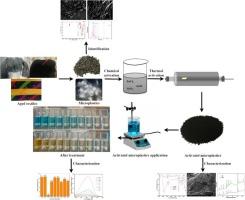从壁橱到污染物再到控制:揭示家用纺织品中的微塑料来源和环境应用潜力
IF 6.3
2区 工程技术
Q1 ENGINEERING, CHEMICAL
引用次数: 0
摘要
纺织业是造成全球污染的重要因素,尤其是通过产生微塑料造成的污染。本研究探讨了微塑料污染这一关键问题,重点是确定降解家用纺织品中微塑料的潜在来源。样本从脱落或磨损的家用纺织品纤维中采集,并使用先进的分析技术进行分析。为了将这些纤维重新用于潜在的环境应用,在 500 °C 下使用 KOH、ZnCl2 和 H2O2 对微塑料进行了化学和热激活,然后将其用于阳离子和阴离子染料修复。结果表明,氯化锌活化的聚氨酯纤维和聚酯纤维对阴离子染料(去除率为 87.69%,吸附容量为 52.13 mg/g)和阳离子染料(去除率为 97.69%,吸附容量为 208.40 mg/g)的修复效率最高,吸附过程中的锌固定化率分别为 99.92% 和 99.91%。此外,还通过傅里叶变换红外光谱、扫描电子显微镜和 X 射线光电子能谱分析,对处理前后的活性微塑料进行了表征,以了解其修复效果。在这项研究中,旧纺织品微塑料的升级再循环不仅首次解决了垃圾填埋场和其他处理场所日益严重的微塑料污染问题,还为废水处理提供了补救措施。研究结果为了解家用纺织品的微塑料污染提供了新的视角,并为管理这种废物提供了解决方案,为管理纺织品废物和减少其对环境的影响提供了新的视角。本文章由计算机程序翻译,如有差异,请以英文原文为准。

From closet to contaminant to control: Unveiling microplastic sources in household textiles and potential for environmental application
The textile sector is a significant contributor to worldwide pollution, especially through the generation of microplastics. This study addresses the critical issue of microplastic pollution and focuses on identifying potential sources of microplastics from degraded domestic textiles. The samples were collected from shed or worn-out fibers of domestic textiles and analyzed using advanced analytical techniques. To repurpose these fibers for potential environmental applications, the microplastics were chemically and thermally activated using KOH, ZnCl2, and H2O2 at 500 °C and then applied for cationic and anionic dye remediation. The results showed that ZnCl2-activated polyurethane and polyester fibers provided the best efficiency for anionic (87.69 % removal, adsorption capacity 52.13 mg/g) and cationic (97.69 % removal, adsorption capacity 208.40 mg/g) dye remediation, and the percentage of Zn immobilization during adsorption was 99.92 % and 99.91 %, respectively. The activated microplastics before and after treatment were also characterized to understand the remediation by Fourier Transform Infrared Spectroscopy, Scanning Electron Microscopy and X-ray Photoelectron Spectroscopy analysis. In this investigation, upcycling old textile microplastic, for the first time, not only addresses the escalating microplastic pollution from landfills and other disposal sites but also provides remediation in wastewater treatment. The findings provide new insights into microplastic pollution from domestic textiles and offer a solution to managing this waste, providing new insights into managing textile waste and reducing its environmental impact.
求助全文
通过发布文献求助,成功后即可免费获取论文全文。
去求助
来源期刊

Journal of water process engineering
Biochemistry, Genetics and Molecular Biology-Biotechnology
CiteScore
10.70
自引率
8.60%
发文量
846
审稿时长
24 days
期刊介绍:
The Journal of Water Process Engineering aims to publish refereed, high-quality research papers with significant novelty and impact in all areas of the engineering of water and wastewater processing . Papers on advanced and novel treatment processes and technologies are particularly welcome. The Journal considers papers in areas such as nanotechnology and biotechnology applications in water, novel oxidation and separation processes, membrane processes (except those for desalination) , catalytic processes for the removal of water contaminants, sustainable processes, water reuse and recycling, water use and wastewater minimization, integrated/hybrid technology, process modeling of water treatment and novel treatment processes. Submissions on the subject of adsorbents, including standard measurements of adsorption kinetics and equilibrium will only be considered if there is a genuine case for novelty and contribution, for example highly novel, sustainable adsorbents and their use: papers on activated carbon-type materials derived from natural matter, or surfactant-modified clays and related minerals, would not fulfil this criterion. The Journal particularly welcomes contributions involving environmentally, economically and socially sustainable technology for water treatment, including those which are energy-efficient, with minimal or no chemical consumption, and capable of water recycling and reuse that minimizes the direct disposal of wastewater to the aquatic environment. Papers that describe novel ideas for solving issues related to water quality and availability are also welcome, as are those that show the transfer of techniques from other disciplines. The Journal will consider papers dealing with processes for various water matrices including drinking water (except desalination), domestic, urban and industrial wastewaters, in addition to their residues. It is expected that the journal will be of particular relevance to chemical and process engineers working in the field. The Journal welcomes Full Text papers, Short Communications, State-of-the-Art Reviews and Letters to Editors and Case Studies
 求助内容:
求助内容: 应助结果提醒方式:
应助结果提醒方式:


